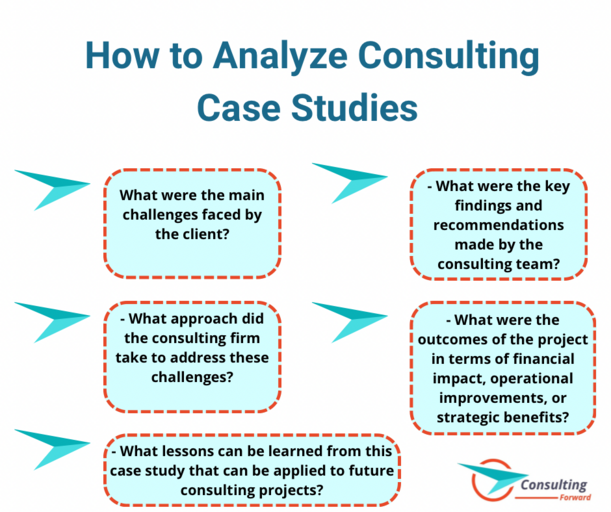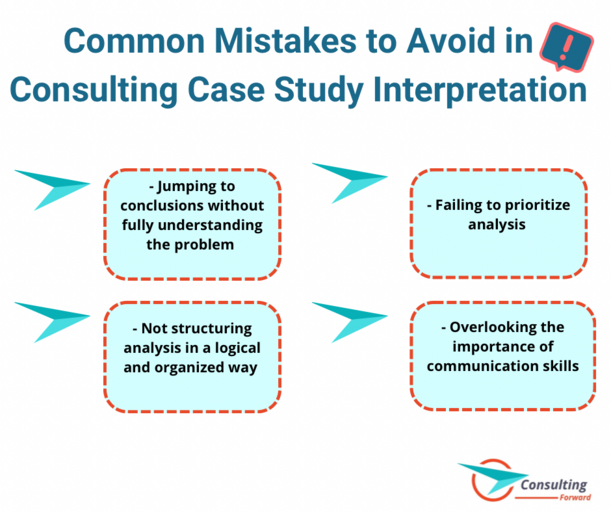All About Consulting Case Studies [+Tips & Example]


Consulting case studies are real-life examples of consulting projects that have been completed by consulting firms. These studies are used to showcase the expertise and problem-solving abilities of the consulting firm, as well as to provide potential clients with an understanding of the type of work that the firm can deliver. Consulting case studies typically detail the challenge that the client was facing, the approach taken by the consulting firm to address the challenge, and the outcomes and results achieved as a result of the project.
Consulting case studies are a valuable tool used by professionals in the consulting industry to showcase their expertise and problem-solving skills. These case studies typically outline a specific business challenge or issue that a client faced, and detail how the consulting firm addressed and resolved the problem. By presenting real-world examples of their work, consulting firms are able to demonstrate their capabilities to potential clients and establish credibility in the industry.
The purpose of consulting case studies is twofold. Firstly, they serve as a means for consulting firms to highlight their success stories and showcase their ability to deliver results for clients. By detailing the specific steps taken to address a particular issue, consulting firms can illustrate their problem-solving process and demonstrate the value they bring to their clients. This can be especially valuable for potential clients who are evaluating different consulting firms and looking for evidence of past success.
Secondly, consulting case studies can also serve as a learning tool for professionals in the consulting industry. By studying successful case studies, consultants can gain insights into different problem-solving approaches, strategies, and best practices. This can help them improve their own consulting skills and better understand how to approach similar challenges in the future. Overall, consulting case studies play a crucial role in showcasing the expertise of consulting firms, attracting new clients, and promoting continuous learning and improvement within the industry.
Analyzing Consulting Case Studies involves breaking down the problem statement, identifying key challenges, understanding the approach taken by the consulting firm, evaluating the effectiveness of the solutions proposed, and assessing the overall impact of the project. By closely examining the details of each case study, individuals can gain a deeper understanding of the consulting process and learn valuable lessons that can be applied to their own projects.
In order to effectively analyze Consulting Case Studies, it is important to ask critical questions such as:

By answering these questions and thoroughly examining the details presented in Consulting Case Studies, individuals can gain valuable insights into the consulting process and learn how to approach similar challenges in their own work.
Case studies are a valuable tool for consultants to showcase their expertise and experience. By presenting a detailed analysis of a client project, consultants can demonstrate their problem-solving skills and the results they have achieved. To create a strong consulting case study, there are several tips to keep in mind.
First and foremost, it is important to choose a relevant and compelling client project to focus on. Selecting a project that highlights your expertise and showcases your ability to deliver results will help to capture the attention of potential clients. Additionally, be sure to include specific details about the client’s goals, challenges, and the solutions you implemented. Providing this context will help readers understand the complexity of the project and the impact of your work.
In addition to outlining the project details, it is important to highlight the results and outcomes of your work. Quantifying the impact of your solutions with specific metrics and data will provide concrete evidence of your success. This information can help potential clients understand the tangible benefits of working with you and can help establish your credibility as a consultant. By following these tips and creating a well-crafted case study, consultants can effectively showcase their skills and attract new clients.
Crafting a compelling case study narrative is essential for capturing the attention of your audience and effectively communicating the value of your work. When writing your case study, it is important to create a clear and engaging narrative that highlights the problem-solving process and the impact of your solutions. Start by outlining the client’s goals and challenges, and then explain how you approached the project and developed a strategic solution.
To keep readers engaged, consider incorporating storytelling elements into your case study. By providing a narrative structure with a clear beginning, middle, and end, you can create a compelling story that draws readers in and keeps them interested. Additionally, be sure to use clear and concise language to explain complex concepts and technical details in a way that is accessible to a wide audience.
Furthermore, don’t forget to include quotes or testimonials from the client to add credibility and perspective to your case study. Hearing directly from the client about their experience working with you can help reinforce the effectiveness of your solutions and build trust with potential clients. By following these tips for writing a compelling case study narrative, consultants can effectively communicate the value of their work and attract new clients.
In addition to crafting a strong case study narrative, the design of your case study is also crucial for capturing and holding the attention of your audience. An engaging layout can help to visually communicate the key points of your case study and make it easier for readers to digest the information. When designing your case study, consider using a clean and professional layout with clear headings, bullet points, and visuals to break up the text and highlight important information.
Incorporating visual elements such as charts, graphs, and images can help to illustrate your key points and make the content more engaging and easy to understand. Including before-and-after comparisons or visual representations of the project’s impact can provide a powerful visual representation of your work. Additionally, be sure to use a consistent color scheme and typography to create a cohesive and visually appealing design.
Furthermore, consider including call-to-action buttons or contact information at the end of your case study to encourage readers to take the next step and reach out to learn more. By designing an engaging case study layout that complements your narrative, consultants can effectively showcase their work and attract new clients.
Consulting case studies are a crucial part of the interview process for landing a job in the consulting industry. In order to succeed, it’s important to avoid common mistakes in interpreting these case studies.
One common mistake is jumping to conclusions without fully understanding the problem at hand. It’s important to take the time to thoroughly analyze the case study and ask clarifying questions if needed. Another mistake is not structuring your analysis in a logical and organized way. This can make it difficult for the interviewer to follow your thought process and ultimately lead to a weaker performance.
Additionally, failing to prioritize your analysis can result in spending too much time on less important aspects of the case study. It’s crucial to identify the most critical issues and address them first in order to demonstrate your problem-solving skills effectively. Finally, overlooking the importance of communication skills can also be a mistake. Clearly articulating your analysis and insights is just as important as the analysis itself.
Overall, by avoiding these common mistakes in consulting case study interpretation, you can increase your chances of success in the interview process and ultimately secure the job of your dreams.

In the world of consulting, data plays a crucial role in shaping case studies and providing valuable insights for clients. When analyzing a business problem or opportunity, consultants rely on data to understand the current state of affairs, identify trends, and make informed recommendations. By collecting and analyzing data, consultants can uncover hidden patterns, correlations, and insights that can lead to more effective solutions.
Data also serves as a foundation for evidence-based decision-making in consulting. When presenting a case study to a client, consultants must back up their recommendations with solid data and analysis. This not only lends credibility to their findings but also helps clients understand the rationale behind the proposed solutions. Without data, recommendations may be perceived as subjective opinions rather than well-supported conclusions.
Data allows consultants to measure the impact of their recommendations and track progress over time. By setting clear metrics and key performance indicators, consultants can monitor the success of their interventions and make adjustments as needed. This data-driven approach helps ensure that consulting projects deliver tangible results and drive long-term value for clients. Ultimately, data is the cornerstone of consulting case studies, providing the evidence and insight needed to drive effective decision-making and create meaningful impact for clients.
One of the key benefits of using data in consulting case studies is its ability to improve decision-making processes. By analyzing data, consultants can identify key opportunities and challenges, assess the potential impact of different strategies, and make informed decisions that lead to better outcomes for clients. Data provides a solid foundation for decision-making, enabling consultants to avoid relying on gut instincts or personal biases.
Moreover, data-driven decision-making in consulting case studies helps mitigate risks and uncertainties. By examining historical data, market trends, and industry benchmarks, consultants can anticipate potential obstacles and develop contingency plans to address them. This proactive approach not only minimizes the likelihood of unexpected setbacks but also increases the likelihood of success for consulting projects.
Data also empowers consultants to test hypotheses, validate assumptions, and explore alternative scenarios in their case studies. By leveraging data analytics tools and techniques, consultants can conduct robust analyses that uncover valuable insights and inform strategic decisions. This iterative process of data-driven decision-making allows consultants to refine their recommendations, optimize their strategies, and deliver greater value to their clients. Ultimately, data enhances the quality of decision-making in consulting case studies, leading to more effective solutions and positive outcomes for clients.
Consulting case studies are a valuable tool for showcasing your expertise and problem-solving skills to potential clients. When it comes to presenting your findings from these case studies, it is important to approach the task with both clarity and creativity.
One effective way to present your findings is to start by clearly outlining the problem or challenge that you were tasked with addressing. This sets the stage for the rest of your presentation and helps your audience understand the context of your work. Next, explain your approach to solving the problem, including any research or analysis you conducted. This shows your audience that your findings are backed up by solid data and evidence.
After presenting your approach, it is important to showcase the results of your work. This could include metrics such as improved efficiency or increased revenue, as well as any qualitative feedback from the client. Highlighting the positive outcomes of your consulting work helps to build credibility and demonstrate the value you provide to clients. Finally, conclude your presentation by summarizing the key takeaways from the case study and reiterating how your skills and expertise can benefit potential clients in similar situations. By following these steps, you can effectively present your findings from consulting case studies in a compelling and convincing way to get more clients.
Visual aids can be a powerful tool for enhancing your consulting presentations and capturing the attention of your audience. When creating visuals for your presentations, it is important to keep a few key tips in mind to ensure that they are engaging and effective.
One important tip is to keep your visuals simple and easy to understand. Avoid cluttering your slides with too much information or complex graphics, as this can overwhelm your audience and distract from your main points. Instead, use clean and clear visuals that help to reinforce your message and make it easier for your audience to follow along.
Another tip is to use a variety of visual formats to keep your audience engaged. This could include charts, graphs, images, and even videos. By mixing up the types of visuals you use, you can create a dynamic and interesting presentation that holds the attention of your audience. Additionally, remember to use visual aids to enhance your verbal presentation, rather than replace it. Your visuals should complement your spoken content and help to reinforce your key points. By incorporating these tips into your consulting presentations, you can create engaging visual aids that help to bring your findings to life and make a lasting impression on your audience.
Deloitte published a great case study for a footwear company. In 2013, a competitor, Badger, launched a successful line of affordable work boots, prompting Duraflex, another footwear company, to rethink their strategy. With limited resources, Duraflex needed to decide whether to focus on competing in the work boot market or strengthening their position in casual boots.
Duraflex sought help from a top consulting firm in January 2014. The consultants conducted research to provide valuable insights for decision-making. They started by conducting a survey with 500 consumers in six key regions. Additionally, they analyzed Duraflex’s internal costs and pricing for both their work and casual boot lines. The analysis revealed that Duraflex was positioned at the premium end of the market for both types of boots.
This case study showcases how consulting firms like Deloitte can provide essential data and analysis to help companies make informed decisions about their business strategies. It’s worth reading as it gives a glimpse into how consulting firms work and the impact they can have on a company’s success.